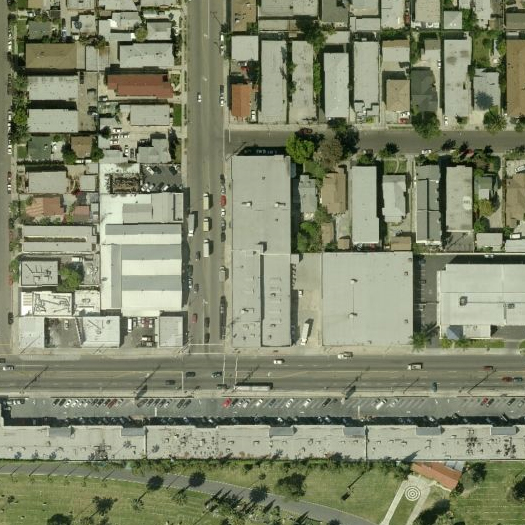
[Omega/Cinema Props’ C.P. Three, at the corner of Santa Monica Boulevard and Bronson Avenue; via bing maps]
At some point, presumably, continuing to open our commentaries on The Infrastructural City by noting that the chapter of the week — in this case, Robert Sumrell’s “Props” — reads significantly different from the other chapters will ring false. But, once again, it’s the obvious place to begin.
Where each of the previous chapters described an aspect of Los Angeles that is reflected in many other cities — cellular networks, property, ubiquitous landscapes of material extraction, post-natural hydrologies — “Props” circles around an infrastructure, the “prop house”, which is essentially unique to Los Angeles, at least in scale and ubiquity. (One suspects that Mumbai, for instance, might rival Los Angeles in density of prop houses, but that is a similarly exceptional case.)
Noting the uniqueness of the prop house to Los Angeles, though, is rather getting ahead of myself, as I’ve neither described what a prop house is nor explained why it might be considered an infrastructure. Very quickly, a prop house is a warehouse that rents objects to the entertainment industry, but the best way to answer these questions is to quote Sumrell, who, after opening with a very specific anecdote about a single prop house — C.P. Three, pictured above — says:
“…no single prop house can claim anything close to a complete material survey of the world. Instead, a variety of prop houses offer highly specialized and themed fragmented utopias, each catering to different needs and subject matters…
There are no standard methods of operation or organization for prop houses. Some are rigorously organized, others are more haphazard. Nonetheless, all prop houses are logistics centers for the storage and circulation of objects. They allow art directors to compare a variety of similar goods to make selections, place the items on hold until final approvals are determined, let the objects out for an agreed upon rental period, and then retain the objects after the transaction is completed in case they should be required again…
Prop houses and film locations are one of the many networks of entertainment support services essential to the survival of Hollywood. While films can be made in any city, the concentration of camera rental facilities, lighting companies, film stages, agents, entertainment lawyers, trained labor, and celebrity talent that are unique to Los Angeles ensure that the region maintains its dominance. If Hollywood specializes in the production of immaterial culture, prop houses and locations are its largest material substrate in the city, grounding it in a prosaic, if extreme, reality.”
Further separating “Props” from the chapters before it is that while the previous chapters told us a great deal about the construction of Los Angeles — infrastructure as sinew — but “Props” is less interesting for what it tells us about the production of urban fabric (the prop house being a relatively rare and unremarkable component of that fabric, even in Los Angeles) and more for what a peculiar piece of that fabric tells us about ourselves.
“Props” accomplishes this by, in addition to relating a history of these peculiar warehouses, also situating the object housed — the “prop” — within a series of architectures, whose scope expands to explore the general cultural significance of the prop: first the prop house, but also passing through the televised dreamland of the commercial, and into the home (and the self-storage unit), which, Sumrell argues, can be understood as a prop house itself. The commercial is the key intermediary in this cultural process, as it is the valuation of the consumer good in advertising as a “purely symbolic” prop which causes goods taken into the home to perform in the same manner. “Once purchased and taken home, the consumer good has to serve both as the symbolic prop that seduced us on television while also performing the function it was ostensibly purchased to accomplish.”
When consumer goods are seen through this lense — as props which import symbolic value into our homes — the prop house can be understood not merely a fantastically odd iteration of warehouse typology, but also a distilled and concentrated architectural moment representative of the sort of broader cultural trends that The Infrastructural City has repeatedly sought to situate infrastructure within:
“The Protestant ethic of thrift and production that Max Weber observed in American culture is long gone. Instead, we have radical abundance propped up by massive debt. Even though consumption is still rampant, we have passed the point of needing to produce more things as a society. Our homes are still prop houses, filled with useless consumer goods that exist primarily to provide a context that we can react to. Our growing relationship to our objects, or props, is that of a programmer to bits of code. As programmers, we assemble these pieces of code into a context, or language, that builds a program to execute a series of actions. Network systems are the infrastructure on which these programs run and interact. No network is essential, just as no single node is vital — all that matters is movement within the network. What we are left with is a constant circulation of bits, like the elements and molecules in chemistry that create a living ecosystem — it is this constant cycle of change that keeps the system vital.
Prop houses provide a utopia for this condition. Not only do they suggest that our Long Tail desires might one day be valuable, they promise that objects can endlessly circulate in an infrastructural condition, provide context and meaning to produce momentarily perfect settings.”
If you’d like to read further about the physical geography of prop houses, I recommend Stefano Bloch’s UCLA thesis, “Properties and Prop-House Geography” (PDF; via DPR-Barcelona).


[…] understandably critical tone, in my reading. I think Mammoth would agree with me for in their own post they note; that Sumrell’s topic is interesting more “for what a peculiar piece of that […]